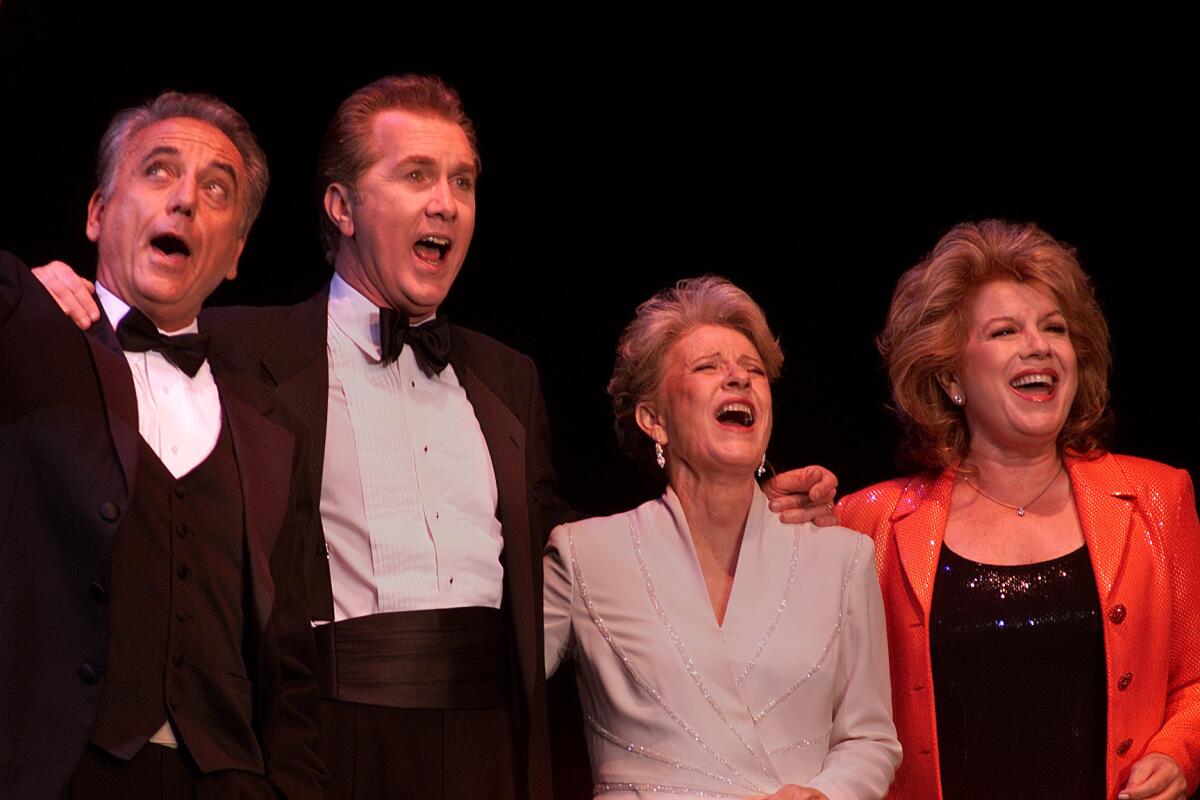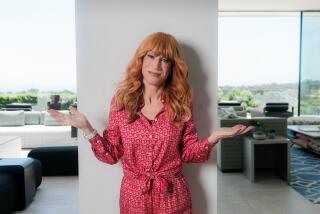From the Archives: Patty Duke was a child star on screen, but a late bloomer on stage

Stage musical “Follies” at the Wadsworth Theatre in Brentwood starring (L to R) Bob Gunton as Ben; Harry Groener as Buddy, Patty Duke as Phyllis; and Vikki Carr as Sally.
Patty Duke, former child star and Academy Award winner, died on Tuesday. She was 69. She may have been a theater veteran, but Duke never sang or danced on stage until Stephen Sondheim’s “Follies” in 2002. We interviewed Duke about preparing for “Follies,” her earlier roles and being manic-depressive while raising children. Here’s our story from June 16, 2002:
Outside the Madeline Clark rehearsal studio on Burbank Boulevard, flowers tumble down white trellises and a cool pool of water beckons weary actors on their breaks. It certainly looks like a mini-arcadia, but here, as elsewhere in Hollywood adjacent, things aren’t always as they seem. Many of the blooms are real, but they’re augmented with plastic impostors. This may be the only garden in town that needs to be both watered and dusted.
Usual expectations have a rough time of it inside the rehearsal hall too. It’s the first cast reading of a new production of Stephen Sondheim’s “Follies,” which opens today, and people are getting to know one another. A petite woman with a short crop of wheat-colored hair walks over to the three young actresses sitting behind her. “Hello,” she says, extending her hand. “I’m Patty Duke.”
The stage manager stands up and delivers a blizzard of announcements, then directs cast members to program his number into their cell phones. Duke looks up in mock consternation. “I’m still learning how to sing and dance,” she says.
Wait, didn’t Duke already know how to dance the minuet? Or was that her Scottish “identical cousin” Cathy, the television alter ego who helped Duke blaze an indelible groove in boomer consciousness with “The Patty Duke Show” from 1963 to 1966 and countless reruns since? Duke went on to reign as the queen of TV movies, with a whopping 76 to her credit.
But the TV movie industry is barely surviving “Survivor” and its clones, not to mention game shows that mint millionaires.
So what else can a girl do but sing Sondheim?
Indeed, at the lofty age of 55, Duke is making her debut as a singer-dancer in the Reprise! production of “Follies,” which runs through June 23 at the Wadsworth Theatre in Brentwood. The show also stars Vikki Carr, Bob Gunton, Harry Groener and Donna McKechnie, as well as Jack Carter, Carol Lawrence and Justine Johnston, who appeared in the original production 30 years ago.
“Follies” resurrects old Broadway in a musical set in a vaudeville theater that’s about to be torn down. The theater owner summons the former hoofers to a reunion, and two couples struggle with the fractures in their marriages against a backdrop of their re-created youth, before their dreams were dashed by their own follies.
The show opened on Broadway in 1971 with music and lyrics by the most sophisticated artist in musical theater. Duke has some musical history herself. As a teen star, she recorded six bubble gum records, including her one hit, 1964’s “Please Don’t Just Stand There.” Her last professional venture in music was the 1965 film, “Billie,” in which she played a singing tomboy who joins the boys’ track team. (Her voice was dubbed over in the soundtrack of the 1967 camp clunker, “Valley of the Dolls.”)
So wouldn’t Sondheim seem like the logical next step?
*
“It’s a leap, isn’t it?” she says and laughs. It’s a couple of days before the first rehearsal, and Duke is being interviewed on a sunny bench outside the darkened Wadsworth. For a TV icon, she looks very much like the nice lady from a small Idaho town that she’s become in recent years. She’s wearing a pink flowered dress topped by an unbuttoned white blouse with short sleeves, barely any makeup and big wire-rimmed glasses that magnify her blue eyes. She speaks in a raspy voice that bears little relationship to the TV teen of yore after so many years of smoking and stress. Duke laughs easily as she explains why she opted to brave her first musical in 35 years.
“One of the things that went into making the decision was that I really wanted to take a risk,” she continues. “I have a wonderful life, but I have not been working in television. That was my bailiwick, and I thought, ‘My God, if not now, when? How many more times are people going to offer me a musical?’
“So here I am,” she says with a hoot. “Terrified.”
Duke, who went public with her 1982 discovery that she was manic-depressive, is famous for facing her fears. When director Arthur Allan Seidelman invited her to audition for the part of Phyllis two months ago, she went for it. Seidelman has known Duke for a dozen years and had worked with her on several projects, including the 1996 TV film “Harvest of Fire,” about arson among the Amish, as well as play readings in L.A. and New York. He thought she’d be perfect for the role of the embittered survivor Phyllis.
The glamorous, world-weary Phyllis has one of the most difficult songs in the show, crammed with rapid-fire, tongue-twisting Sondheim-isms. In “The Story of Lucy and Jessie,” Phyllis sings about the two rivals for her husband’s love--herself (Jessie) and the housewife Sally (Lucy), or “juicy but drab Lucy and dressy but cold Jessie.”
“I just thought that she was a brilliant actress and has all the qualities that are so right for Phyllis--intelligence, emotional complexity,” Seidelman says. “She’s at a perfect point in her life to play Phyllis. I also knew that she sang and was interested in doing musicals, so I put it all together.”
*
Duke’s career began on the stage in 1959, when she played Helen Keller in the Broadway production of “The Miracle Worker,” a role she re-created on film in an Oscar-winning performance. At the time, the New York Times raved, “As Helen, little Miss Duke is altogether superb.”
In the ‘70s, she performed in theaters around the country, sometimes with her third husband, John Astin. But by the ‘80s, her stage career had dwindled to a trickle, drying up completely after a 1990 run of “Meetings on the Porch” at the Canon Theatre in Beverly Hills. So by the time Seidelman asked her to do a reading of Richard Alfieri’s “The Sisters” in L.A. five years ago, the stage was a distant memory for her.
“It was almost foreign to me, and I wasn’t sure I understood the play all that well,” Duke says. “I got two lines out of my mouth, and the audience roared with laughter. I suddenly knew what the play was about. And it was that kind of night for me where I could do no wrong. It was like the manic highs, and what that is, of course, is the drug that keeps you coming back for more.” Since then, she’s been getting most of her fixes in civic theater in Spokane, Wash., near her home in northern Idaho.
When Duke arrived for her “Follies” audition, Seidelman asked the production’s music director, Gerald Sternbach, to help prepare her. “She was really gung-ho when I vocalized her, and she sight-read it a little bit,” Sternbach says. “She’s musical enough to hit the notes and, because of her instincts, she gets the values of the lyric and the arc of the piece.”
Duke was offered the job on the spot. “She has the perfect voice for Phyllis,” Seidelman says. “It’s filled with the dramatic intensity and bite that is Phyllis.”
When Duke returned to Idaho, she got to work. For the next two months, she spent four hours a day, six days a week, working with singing and dancing coaches from a local college. Oddly enough, those were the first lessons she’d ever had, because the Svengali-like couple who managed her as a child and made her a star never bothered with them.
“It’s fascinating to me that they did not insist that there be those kinds of lessons,” Duke muses. “But she [Ethel Ross] was a dancer, and she decided if I ever needed to dance, she’d teach me the five steps I needed and that would be that. Then when I got away from them on my own, I was so involved in my own mental illness and getting married and having children, the idea of going to tap-dance classes didn’t come up.”
Ethel Ross and her then-husband, John, isolated her from her family, subjected her to relentless work and changed her given name from Anna Marie, declaring, “Anna Marie is dead.” She recounted her childhood trials--as the daughter of a chronically depressed mother who kicked out her alcoholic father when she was 6--in the first of two best-selling memoirs, “Call Me Anna” (1988), written with Los Angeles Times film critic Kenneth Turan.
But she’s quick to point out that the couple who claimed her youth also protected her by seeing that she owned one-third of “The Patty Duke Show,” which produced income for her when it was rerun on Nickelodeon’s Nick at Nite until a few years ago.
*
Now that she has some distance from that painful period, Duke can count her blessings. “When you walk down the street and a total stranger sings a 40-year-old theme to you, you go, ‘Someone was paying attention.’ I love it! Strangers nod and smile or call out, ‘I love you.’ What a nice way to go through life. Other people don’t even say ‘excuse me’ to other people, and a total stranger is sending me love vibes.”
The reruns have also generated a new crop of fervent fans. Not long ago, a group of nine college-age Patty Duke aficionados from around the country traveled to Spokane to catch a stage performance. After the show, she invited them to the 80-acre farm she shares with her firefighter husband, Michael Pearce, 47, adopted son Kevin, 13, and 53 llamas, horses, miniature donkeys and horses, goats, sheep and dogs.
“What was most fun--or most frightening, I’m not sure which--was one would start talking about an episode of the old series, and they’d all pick it up,” she says. “They knew every line. When they went home, I hugged and kissed each one of them and said, ‘Now get a life!’ ”
Duke moved on long ago. “Patty” doesn’t play much of a role in her personal life, where she’s known as Anna. Her family calls her Anna Banana. And now that her actor son Sean Astin, 31, has a child of his own and another on the way, she’s become Nana Anna Banana.
After she married Pearce in 1985, Duke became stepmother to his daughters, Charlene, 24, a genetic researcher, and Raelene, who drowned in a 1998 car accident at age 22. The wound hasn’t totally healed yet.
“I’ll see a girl driving in a car and her hair seems to be the same way and you go....” She gasps. “I thought maybe I was just being mentally ill, but my husband says that he has the same experience. We seem to be at a rather calm place, but even that will get better for us as we decide what it is we believe in terms of the larger picture. I mean, I believe, then I don’t believe. I’m hoping God’s ego will handle it OK,” she says and laughs.
As for her other children, Duke says she’s grateful for her close relationships with Sean and his actor brother, Mackenzie Astin, 29, despite the rough childhood to which she subjected them before her illness was diagnosed.
“I had no patience,” she says. “This was not all the time. The thing that these kids had going against them was that you never knew when what was all hunky-dory was going to fly out the window and you were going to be screamed at and berated and either ostracized or made to do some humiliating punishment.”
Mac has told her he’s finally ready to write a memoir about those years, which leaves her with mixed emotions. “My stomach goes grrrrr. We know what he’s going to write about. And I really have told everything I can tell without impeding on the privacy of other people.
“But as painful as it might be for me, it will also be remarkably interesting to finally really hear it from their point of view. They just sort of said, ‘She’s OK now. She’s taking her pills.’ Well, that’s not enough for them. They have to examine it further. And if that means making Mom look not so good, that’s the way it was.”
But since there are indeed second acts in life, Duke is hoping that hers will be a robust career on the stage, ultimate destination New York. Meanwhile, she’s bonding with her fellow thespians in the strange garden on Burbank Boulevard, where she’s taking a cigarette break. At one point, Sternbach goes over to her and bends down to embrace her 5-foot frame.
“I’m so proud of you,” he stage-whispers into her ear. “Fearless. You’re fearless.”
More to Read
The biggest entertainment stories
Get our big stories about Hollywood, film, television, music, arts, culture and more right in your inbox as soon as they publish.
You may occasionally receive promotional content from the Los Angeles Times.










